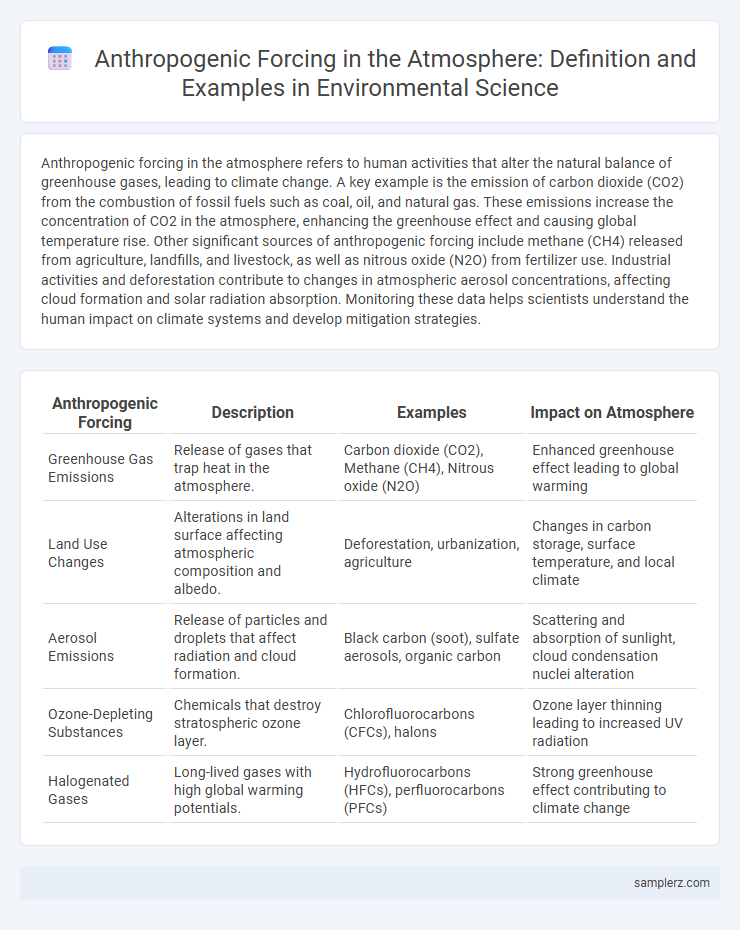Anthropogenic forcing in the atmosphere refers to human activities that alter the natural balance of greenhouse gases, leading to climate change. A key example is the emission of carbon dioxide (CO2) from the combustion of fossil fuels such as coal, oil, and natural gas. These emissions increase the concentration of CO2 in the atmosphere, enhancing the greenhouse effect and causing global temperature rise. Other significant sources of anthropogenic forcing include methane (CH4) released from agriculture, landfills, and livestock, as well as nitrous oxide (N2O) from fertilizer use. Industrial activities and deforestation contribute to changes in atmospheric aerosol concentrations, affecting cloud formation and solar radiation absorption. Monitoring these data helps scientists understand the human impact on climate systems and develop mitigation strategies.
Table of Comparison
| Anthropogenic Forcing | Description | Examples | Impact on Atmosphere |
|---|---|---|---|
| Greenhouse Gas Emissions | Release of gases that trap heat in the atmosphere. | Carbon dioxide (CO2), Methane (CH4), Nitrous oxide (N2O) | Enhanced greenhouse effect leading to global warming |
| Land Use Changes | Alterations in land surface affecting atmospheric composition and albedo. | Deforestation, urbanization, agriculture | Changes in carbon storage, surface temperature, and local climate |
| Aerosol Emissions | Release of particles and droplets that affect radiation and cloud formation. | Black carbon (soot), sulfate aerosols, organic carbon | Scattering and absorption of sunlight, cloud condensation nuclei alteration |
| Ozone-Depleting Substances | Chemicals that destroy stratospheric ozone layer. | Chlorofluorocarbons (CFCs), halons | Ozone layer thinning leading to increased UV radiation |
| Halogenated Gases | Long-lived gases with high global warming potentials. | Hydrofluorocarbons (HFCs), perfluorocarbons (PFCs) | Strong greenhouse effect contributing to climate change |
Overview of Anthropogenic Forcing in the Atmosphere
Anthropogenic forcing in the atmosphere primarily involves the emission of greenhouse gases, such as carbon dioxide, methane, and nitrous oxide, which result from fossil fuel combustion, agriculture, and industrial activities. These emissions intensify the natural greenhouse effect, leading to global warming and climate change. Deforestation and aerosol release further alter atmospheric composition, significantly impacting radiative forcing and atmospheric chemistry.
Greenhouse Gas Emissions from Fossil Fuel Combustion
Greenhouse gas emissions from fossil fuel combustion represent a primary example of anthropogenic forcing in the atmosphere, significantly contributing to global warming and climate change. Carbon dioxide (CO2) released during the burning of coal, oil, and natural gas increases the atmospheric greenhouse effect, trapping heat and altering climate patterns. Industrial activities and transportation sectors are major sources of these emissions, driving long-term atmospheric changes and enhanced radiative forcing.
Industrial Release of Aerosols and Particulates
Industrial release of aerosols and particulates significantly contributes to anthropogenic forcing by increasing atmospheric particulate matter concentrations. Factories, power plants, and manufacturing processes emit sulfur dioxide (SO2), nitrogen oxides (NOx), and black carbon, which alter cloud properties and reduce solar radiation reaching the Earth's surface. These industrial aerosols influence climate patterns by enhancing cloud reflectivity and modifying regional temperature distributions.
Impact of Deforestation on Atmospheric Composition
Deforestation significantly alters atmospheric composition by increasing carbon dioxide levels through the release of stored carbon in trees. This anthropogenic forcing reduces the capacity of forests to act as carbon sinks, intensifying greenhouse gas concentrations. The loss of forest cover also disrupts local and regional climate patterns by changing surface albedo and evapotranspiration rates.
Agricultural Practices and Methane Emissions
Methane emissions from agricultural practices, particularly enteric fermentation in livestock and rice paddies, are significant contributors to anthropogenic forcing in the atmosphere. These activities release methane, a potent greenhouse gas with a global warming potential roughly 28-36 times greater than carbon dioxide over a 100-year period. Mitigating methane emissions through improved livestock management and modified rice cultivation techniques is crucial for reducing agriculture's impact on climate change.
Urbanization and Heat Island Effects
Urbanization significantly alters atmospheric conditions by replacing natural vegetation with impervious surfaces, increasing heat absorption and retention. This leads to the Urban Heat Island effect, where cities experience higher temperatures than surrounding rural areas, intensifying local warming and affecting weather patterns. Increased energy consumption and pollution emissions from urban activities further amplify atmospheric forcing and contribute to climate change.
Contribution of Transportation to Air Pollution
Transportation significantly contributes to anthropogenic forcing by emitting greenhouse gases such as carbon dioxide (CO2) and nitrogen oxides (NOx), which degrade air quality and intensify climate change. Vehicular emissions account for approximately 14% of global greenhouse gas emissions, with urban areas experiencing elevated levels of particulate matter and ozone precursors. Shifts towards electric vehicles and improved fuel standards are critical strategies to mitigate transportation-related atmospheric pollution.
Ozone Depletion Due to Human Activities
Ozone depletion in the stratosphere is primarily driven by anthropogenic emissions of chlorofluorocarbons (CFCs) and halons, which release chlorine and bromine atoms that catalytically destroy ozone molecules. The significant reduction of the ozone layer results in increased ultraviolet (UV-B) radiation reaching the Earth's surface, causing adverse effects on human health, ecosystems, and climate. International agreements like the Montreal Protocol have been effective in phasing out many ozone-depleting substances, contributing to the gradual recovery of the ozone layer.
Influence of Land Use Change on Atmospheric Forcing
Land use change significantly influences atmospheric forcing by altering surface albedo, greenhouse gas emissions, and evapotranspiration rates. Deforestation and urbanization increase atmospheric carbon dioxide and methane levels, intensifying radiative forcing and contributing to climate change. These transformations disrupt local and regional climate patterns, highlighting the critical role of land management in controlling anthropogenic climate impacts.
Policy Responses to Mitigate Anthropogenic Forcing
Policy responses to mitigate anthropogenic forcing in the atmosphere include implementing carbon pricing mechanisms such as carbon taxes and cap-and-trade systems, which incentivize emission reductions from industrial sources. Governments also enforce regulations limiting greenhouse gas emissions through standards for vehicle fuel efficiency and industrial emissions. Investment in renewable energy technologies and reforestation programs further contribute to decreasing atmospheric concentrations of CO2 and other pollutants driving climate change.

example of anthropogenic forcing in atmosphere Infographic
 samplerz.com
samplerz.com